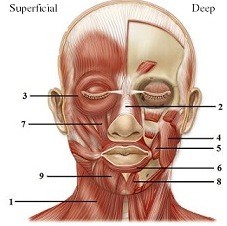 This figure shows the muscles of facial expression. What muscle does number 3 indicate?
This figure shows the muscles of facial expression. What muscle does number 3 indicate?
A. Platysma
B. Epicranius
C. Orbicularis oris
D. Orbicularis oculi
E. Nasalis
Answer: D
You might also like to view...
The tall slender body shape that helps to dissipate heat in people native to equatorial regions is an example of
A. homeostasis. B. phase shift. C. set point resetting. D. an adaptation. E. acclimatization.
In a normal person at rest, the part of the respiratory cycle in which no air is flowing through the airways and the respiratory muscles are relaxed is at the end of inhalation/inspiration, prior to exhalation/expiration.
Answer the following statement true (T) or false (F)
The sympathetic trunks are located
A. superior to the brachial plexus. B. inferior to the sacral plexus. C. immediately lateral to the vertebral column. D. lateral to prevertebral ganglia. E. in the craniosacral regions.
If a 10% sucrose solution is separated from a 20% sucrose solution by a membrane impermeable to sucrose, in which direction will net movement of water occur?
A) from the 20% sucrose solution to the 10% sucrose solution only B) from the 10% sucrose solution to the 20% sucrose solution and from the 20% sucrose solution to the 10% sucrose solution C) There will be no net movement of water in this case. D) from the 10% sucrose solution to the 20% sucrose solution only E) None of the answers are correct.